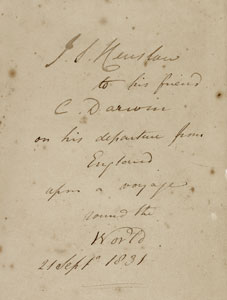'A voyage round the world'
 |
|---|
| John Stevens Henslow's inscription in Humboldt's Personal Narrative, given to Darwin just before the voyage. CUL DAR Lib |
It has been described as ‘the most significant gap year in history’. In 1831 Charles Darwin, an able but untried Cambridge graduate, left England aboard HMS Beagle on what was originally intended as a two-year Admiralty expedition, surveying the coast of South America. Two years stretched to three, and then close to five. When Darwin returned from ‘by far the most important event in my life’, it was as an eagerly awaited member of the scientific establishment.
Cambridge played a vital role in this transformation. Darwin’s Cambridge connections secured his place on the Beagle; his Cambridge friends and teachers sent advice, encouragement and responses to his ideas, and arranged for his discoveries to be promoted and published; and it was to Cambridge that vast numbers of specimens were shipped in caskets, barrels, jars and pill-boxes. Today the University houses the main archive of Darwin’s papers, and significant collections of his rocks, minerals, fossils, animals, birds and plants.

